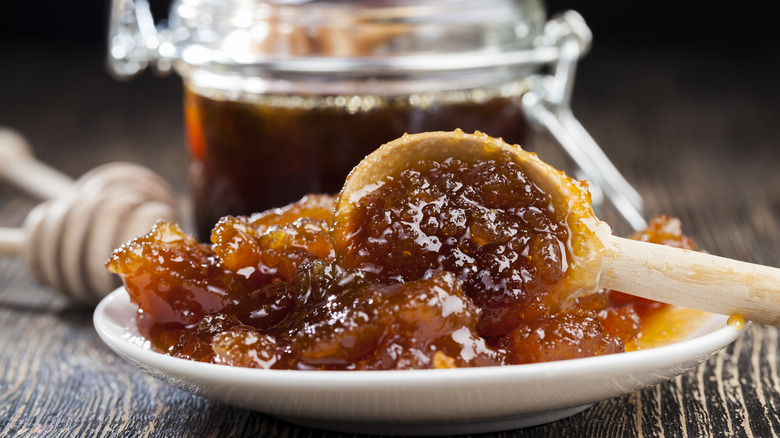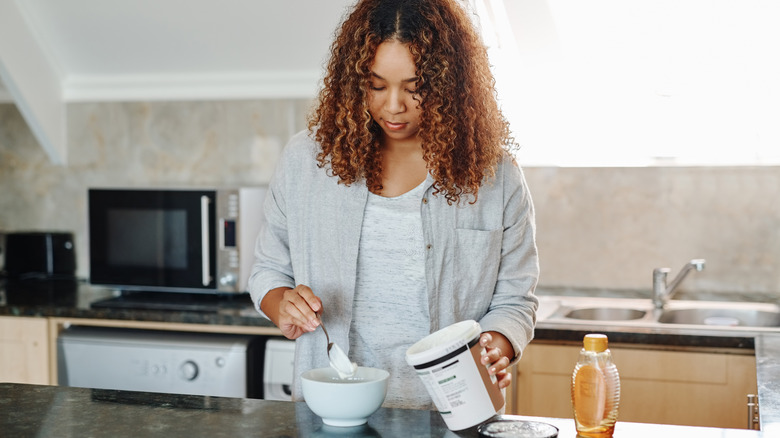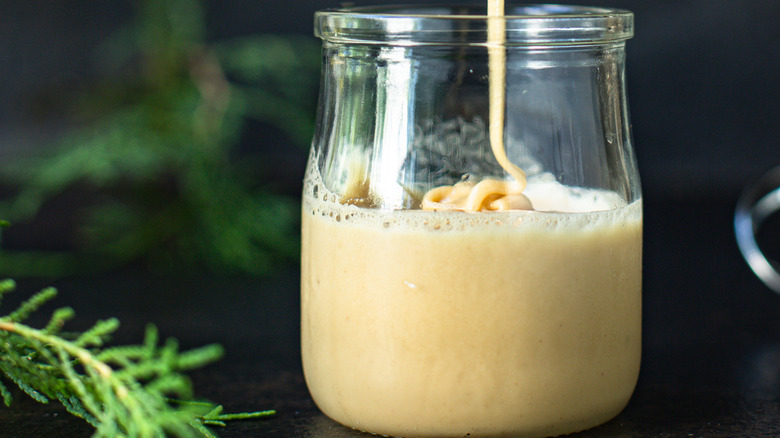What To Do With Honey When It's Already Crystallized
When archaeologists discovered King Tut's tomb, they found him buried with 3,000-year-old jars of honey. While it was crystallized, it was still edible, and that's because honey is one of the only naturally occurring foods that does not go bad. This is by design; bees collect nectar, break it down with enzymes, and dehydrate it. This creates honey, and they store it in their combs as a long-lasting energy source. Three cheers to bees for figuring this one out.
So, when the same kind of archeological dig occurs while reaching deep into the kitchen cabinets, the unearthed crystallized jar of honey should not be tossed in the trash. In fact, it is quite easy to de-crystallize honey with just a little bit of heat. If the honey is in a plastic bottle, use a spoon to scoop it out and place it in a glass jar. Put the jar in a pot filled with enough warm water to match the level of the honey. The water temperature should not exceed 110 degrees Fahrenheit; temperatures higher than this start to touch honey's burning point. Monitor the water temperature to keep it consistent and, within an hour or so, the honey will be back to liquid form.
Using crystallized honey can enhance certain recipes
If honey is crystallized, and there isn't a spare hour to liquefy it, there are still plenty of uses for the solidified sweet. Since heat is the cure, it's only natural to drop it in a cup of tea; the crystals will melt rather quickly. It also makes a fine accompaniment to most breakfast foods that would traditionally use liquid honey, adding a crunchy texture. Spoon crystallized honey onto Greek yogurt and granola, use it as a topping for Ina Garten's oven-baked pancakes, or replace the maple syrup in this matcha overnight oats recipe.
Crystallized honey can also act as a sugar replacement in baking recipes. Normally, if honey is acting as a sweetener for cookies or breads, the other liquids in a recipe would have to be altered. However, since crystallized honey has even less moisture than the liquid variety, no changes are needed. Just a warning: Honey is sweeter than processed sugar, so using a quarter cup less is recommended.
Crystallized honey can be transformed into smooth whipped honey
If the texture of crystallized honey is not to your taste, there is another way to make it something new. Whipped honey — also called creamed honey — is a smooth, spreadable variation that is far less viscous than its raw form. It is created by controlling the crystallization of honey, which actually has to do with temperature — too hot, and the whipped honey will melt back to its liquid state. One of the key ingredients in whipped variety is crystallized honey, often called "seed honey," which is mixed with the liquid stuff. Here's how to make it.
Take crystallized honey and either crush it with a mortar and pestle or finely grind it with a food processor. In a one-to-one ratio, mix the powder with regular liquid honey. Slowly mix either by hand or with a machine on low setting for 20 minutes, watching the honey become paler in color, and then let it rest. This process can be repeated several times until the whipped honey reaches your desired consistency and color. Pour it into a jar with a tight lid and seal it back into the cabinet tomb. Just keep it near the front this time.



